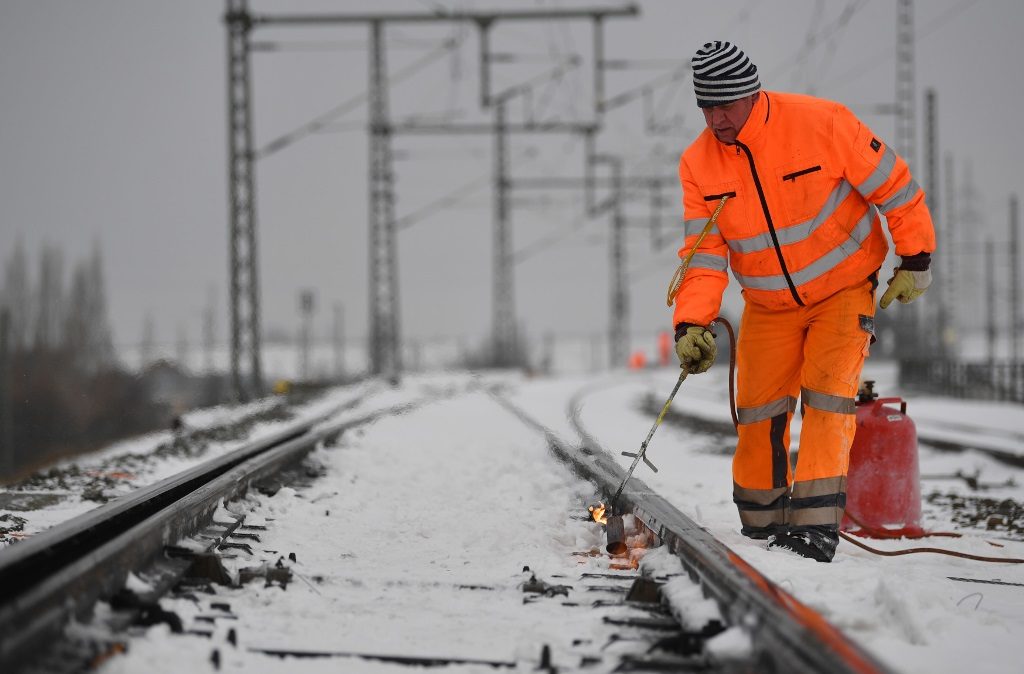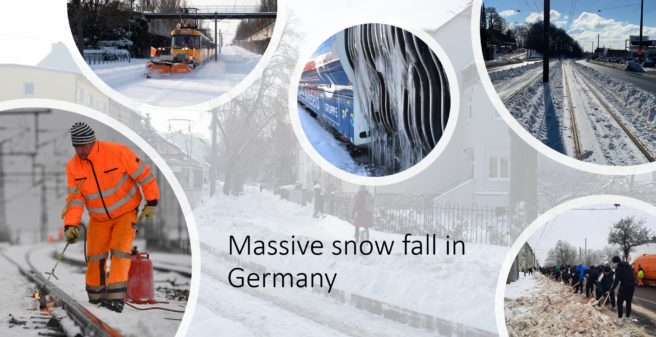
Broken down vehicles, major problems in rail traffic and lots of snow. This has not happened for decades, at least in western and central Germany. In some places, more than 30 centimetres fell within a few days. In addition, there were drifts several metres high.
As a result, a new word has been created in the German language: “Flockdown”, referring to lockdown (the Corona restrictions) and “Flocke”, German for “snow flakes”.
The police and fire brigade had to be called out in many cases. Both public and rail transport in many regions of North Rhine-Westphalia, Lower Saxony, Saxony, Thuringia came to a complete or partial standstill.
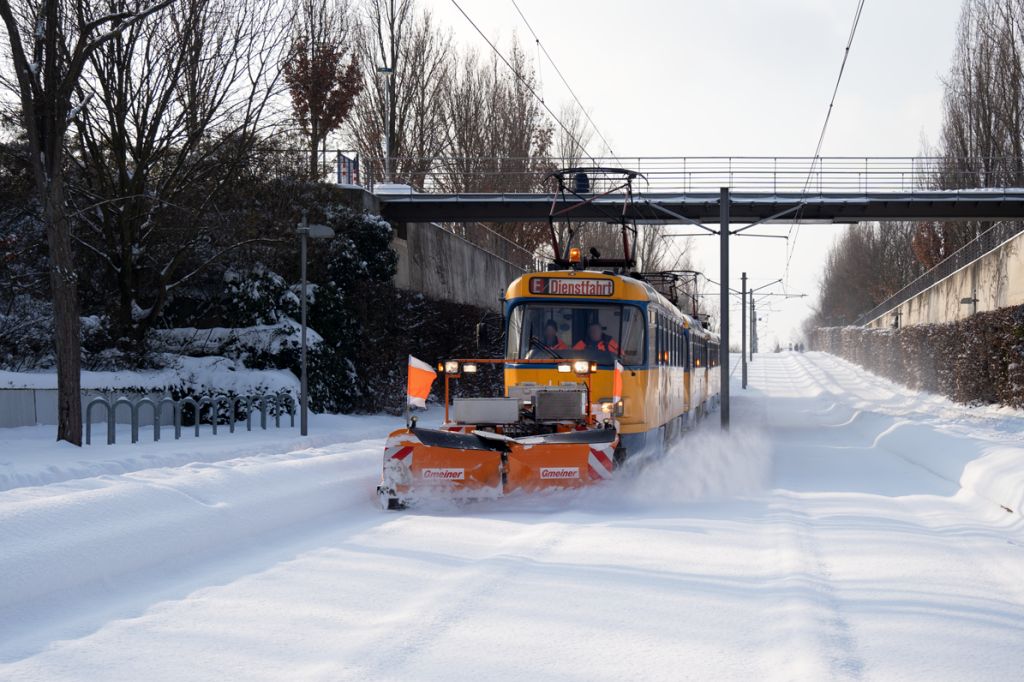
Snow is actually part of winter in Central and Northern Europe. However, in recent years snow, or at least snow that stays on the ground, has become a rarity at medium altitudes. According to meteorologists, the heavy snowfall is only a short-term weather phenomenon. The German Weather Service reported in December 2020 that the year in Germany, with an annual mean temperature of 10.4 degrees Celsius (°C), was the second warmest year since nationwide weather records began in 1881.
But can it be that so much snow falls at once? One of the reasons for the unusually strong winter is, among other things, the high air pressure that prevailed from the Arctic Ocean to Central Europe. This causes extremely cold air from the polar region to be pushed directly into northern Germany and neighbouring countries. Temperatures of below 20 degrees Celsius were measured.
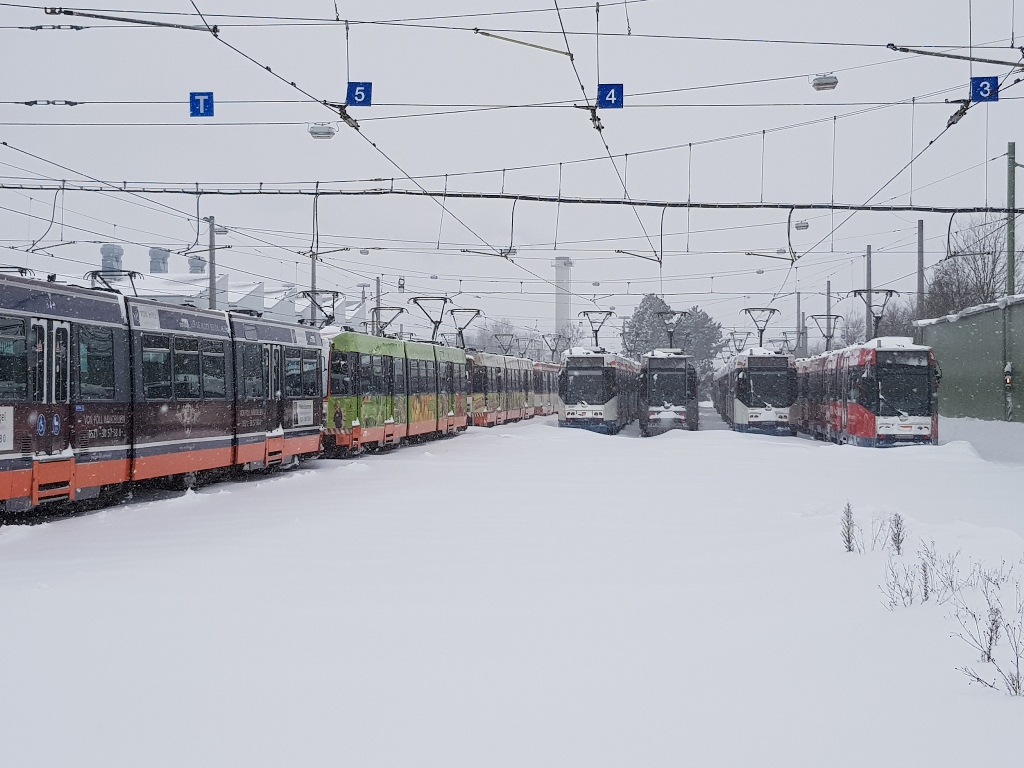
The impact on public transport
How did the transport companies deal with the masses of snow? Although the staff was on the alert and in some places the trams also ran through the night to keep the frost and snow off, between 6 and 7 February, many routes and roads were snowed in, so that public transport and road traffic to a complete came to a complete standstill. Since many transport companies did not have snow ploughs and road-based snow ploughs were not sufficient, some cities had to “lend a hand”. Employees and managers were equipped with high-visibility waistcoats and snow shovels at short notice in order to literally shovel tracks, switches and stops free. We would like to take this opportunity to thank the employees of the transport companies for their for their tireless efforts in the extreme temperatures. Buses and trams remained in the depots, often with the heating on, to avoid freezing.
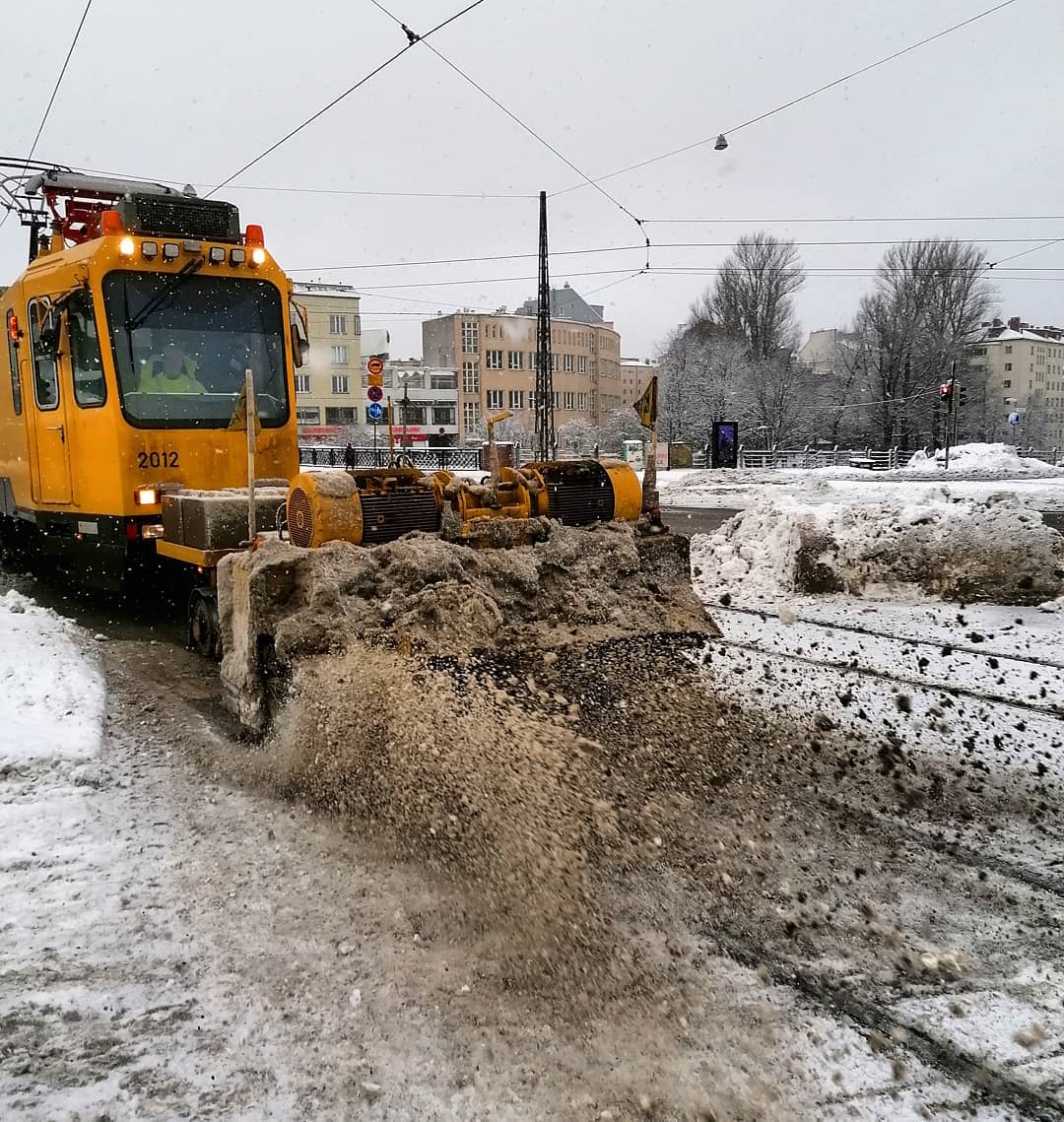
Impact for passengers
Many commuters, especially those who could not work from home offices, could not get to work. The mobility guarantee is only valid up to severe weather warning level 3, which was declared in parts of the of the country on 6 February. Since the severe weather warning level 3 was lifted again has been lifted, the mobility guarantee also applies again. This means that the transport operators will reimburse taxi fares after a 30-minute wait.
Also in the Spanish capital Madrid there was more snow at the beginning of January than it had for decades. Bus and tram services were completely suspended since 9/1/2021, with the exception of the Metro Ligero line ML1 underground section between Pinar de Chamartin and Virgen del Cortijo. In return, the metro ran around the clock for the first time for one week. From 13/1/2021, partial lines were operated again, and from 15/1 all lines were operated largely as normal. The same applied to the nearby ring tramway Tranvía Parla.
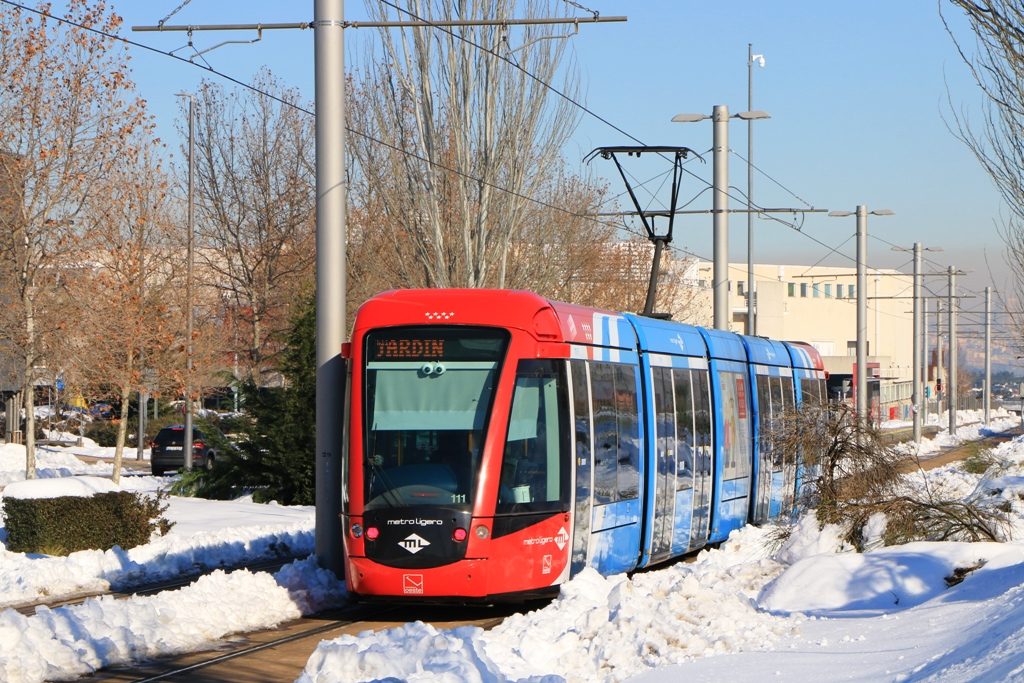
Citadis tram in Madrid I © UTM/ DB 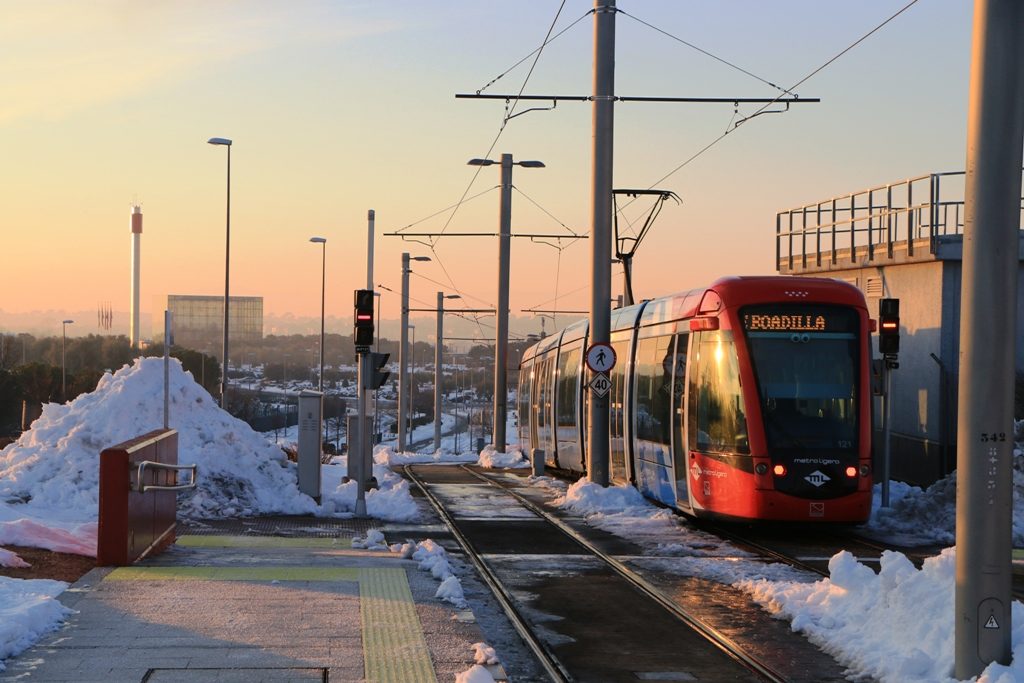
Service on the Metro Ligero Lnie ML1 was not interrupted I © UTM/ DB
The regions most affected by the snow in Germany extend from the eastern Ruhr area (Mülheim/Essen) via Bremen and Hanover to Saxony (Leipzig). It did snow in other regions as well, e.g. in Berlin, but here public transport could be maintained as far as possible. could be maintained.
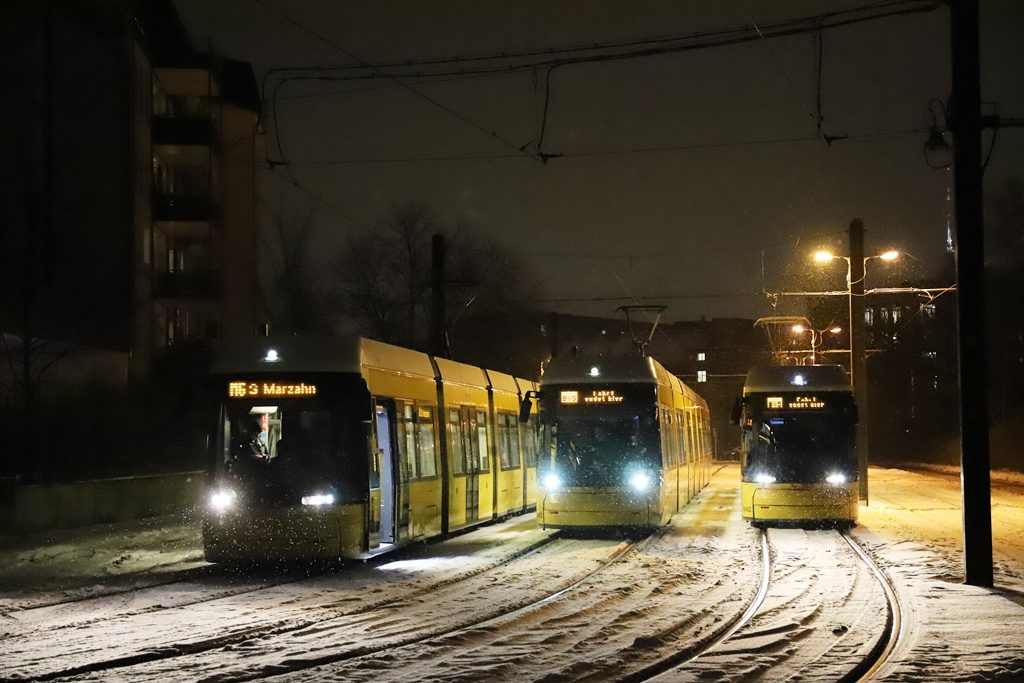
Compared to other cities, the snowfall in Berlin was relatively light – three Flexity at Volkspark Friedrichshain I © UTM 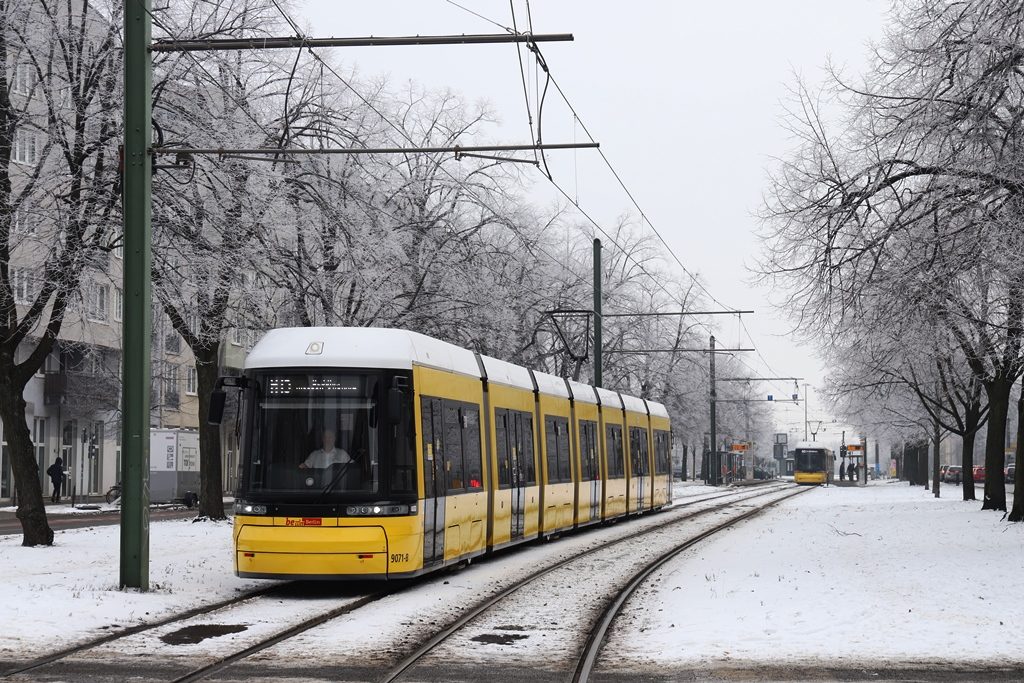
BVG tram, bus and metro services were hardly affected at all by the snow I © UTM 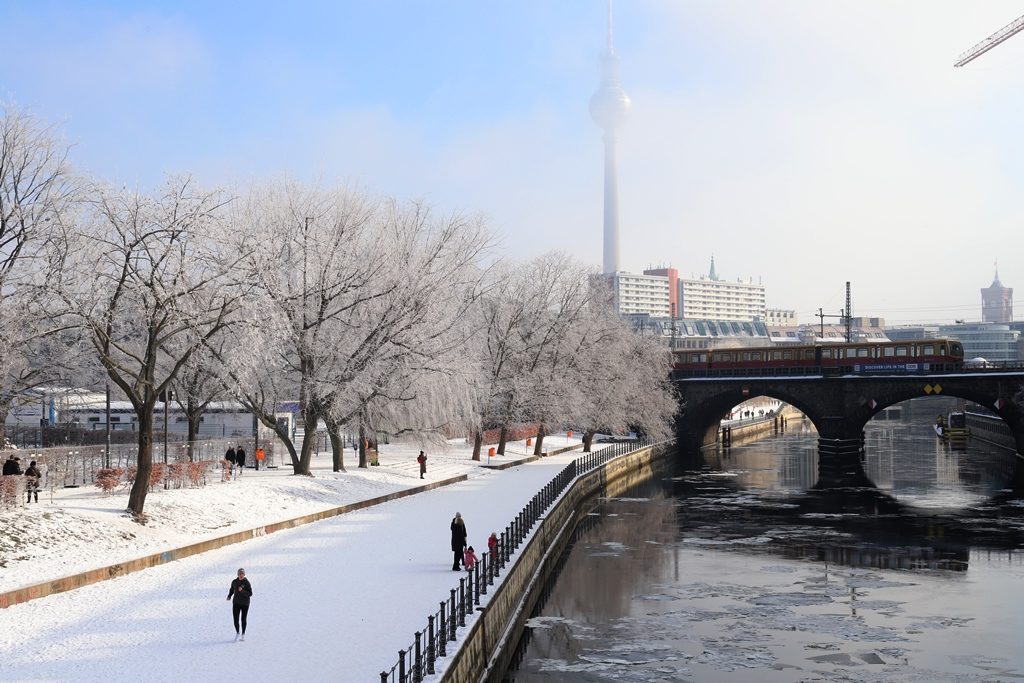
On the weekend of 13/14 February, the sun made for very wintry views in Berlin – an S-Bahn at Museum Island in Berlin I © UTM
An overview without claim to completeness (status 13/02/2021):
Bielefeld
The Bielefeld public transport company, moBiel, shut down all bus and tram services on Monday due to the weather. The accumulated snow reached up to almost 1 metre high platforms of the light rail system. This made the operation impossible. The snow would accumulate underneath the trams and this could lead to derailments. moBiel described the situation as serious, as the permanent snow was expected to continue for the next two weeks. On Friday, 12/02 a shuttle service began to operate on some sections of the network. Several vehicles were broken down due to the snowstorm.
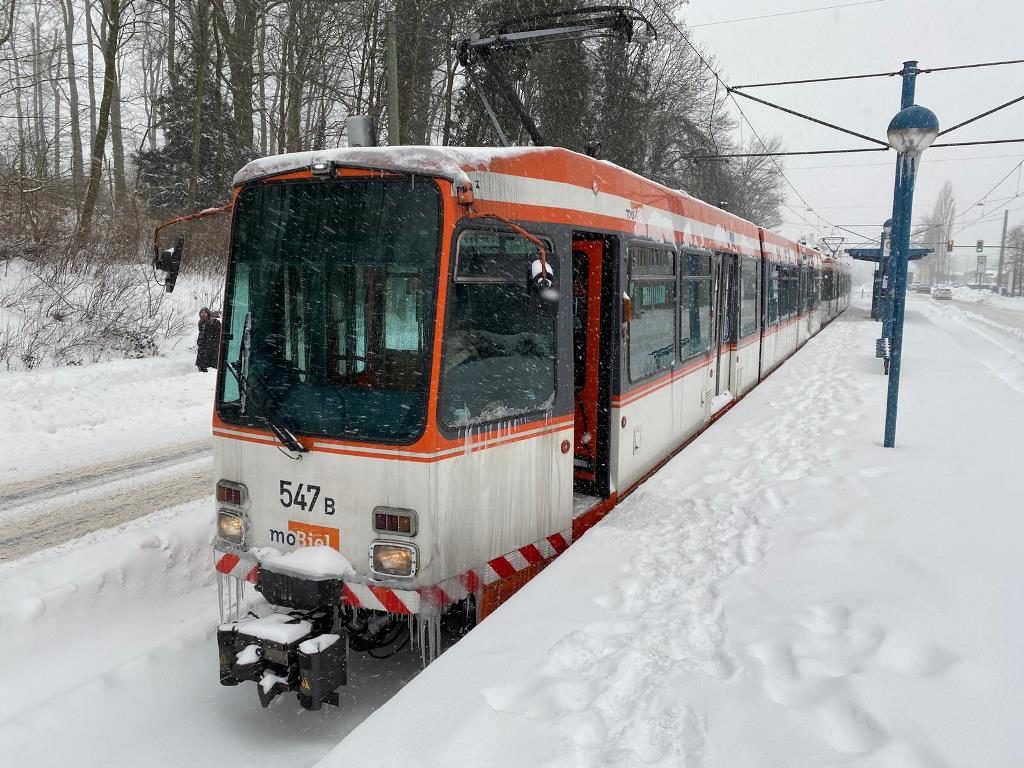
Some M8C light rail vehicles had to break down due to the masses of snow – here in Brackwede station I © Boris Pareigis 
A bus replacement service was gradually set up I © Boris Pareigis
According to moBiel, this winter weather presented completely new challenges. In the last decades there has never been such an exceptional situation. “We are on site with all available forces and are trying to make everything possible. We have even deployed more staff in advance and let the trams run at night to keep the tracks clear”, emphasised Martin Uekmann, Managing Director of moBiel.
„Bielefeld is not like Bavaria“
“That so much snow falls in only two days snow falls once in a quarter of a century. In Bavaria they are prepared for such situations. Almost all private households there are equipped with snow blowers and provide additional support,” said Martin Uekmann. “If we wanted to equip the municipal operations for these exceptional situations, this would of course lead to high costs,” Uekmann clarified.
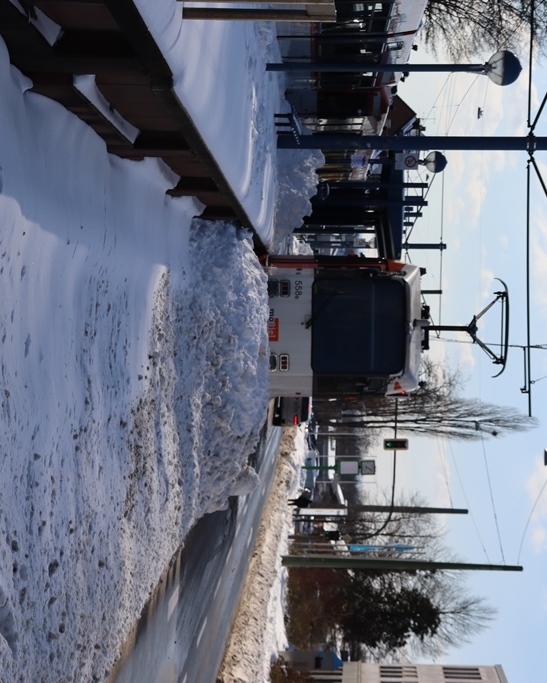
No progress – parked M8C railcar in Bielefeld Brackwede I © Boris Pareigis 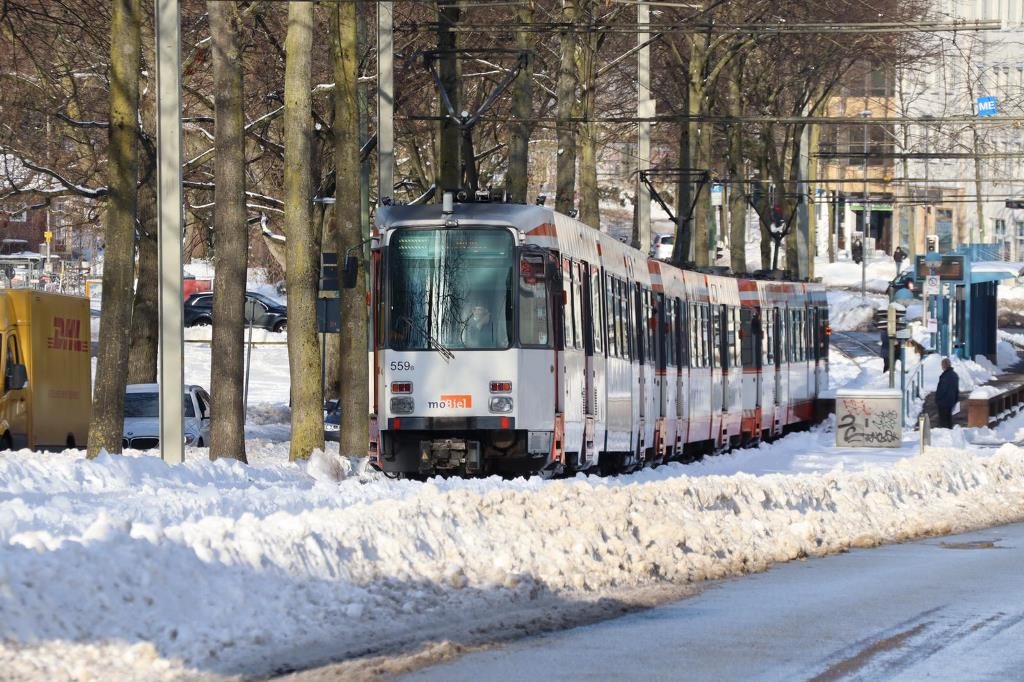
Never seen before: M8C triple traction in Bielefeld for the evacuation of railcars I © Boris Pareigis 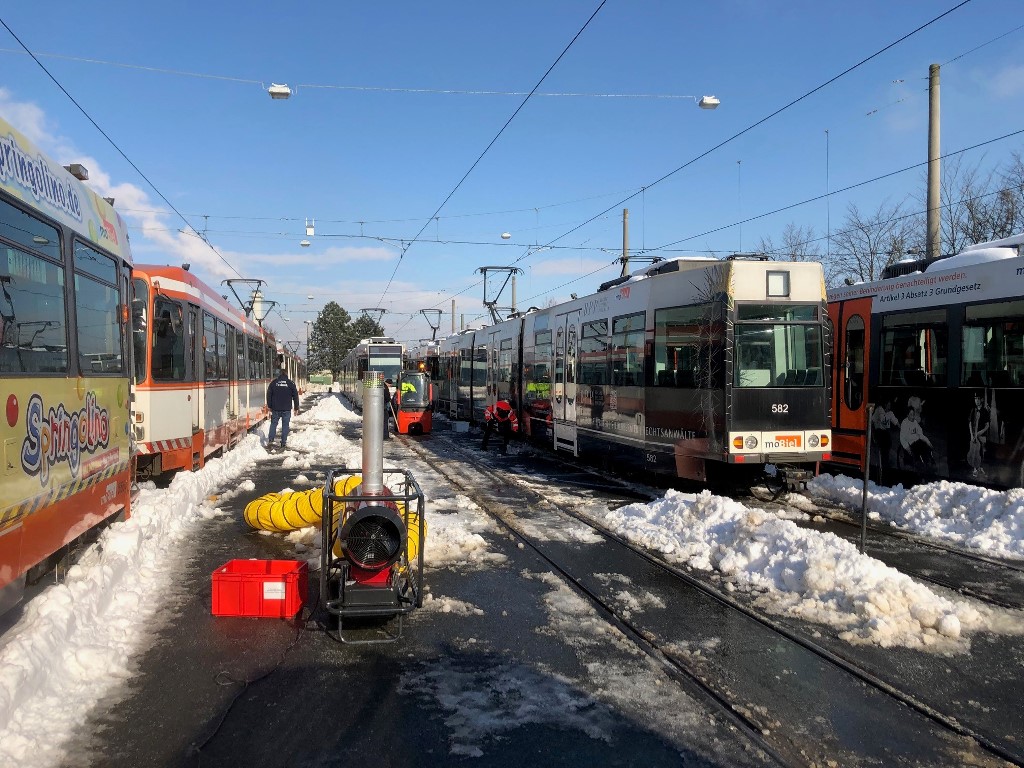
On 12 and 13 February, the light rail vehicles are prepared in Bielefeld’s depot for the start on Monday, 15 February I © moBiel/ Schönenberg
The bus service started on Wednesday, 10/02 with a main axis between the city centre and Heepen. The moBiel traffic controllers were constantly on the road, checking which routes are feasible. This is a huge task, because Bielefeld is an city with a large bus network. Many streets were passable, but but were too narrow for the buses – moBiel uses articulated buses for the most part. In addition, the bus stops are covered with snow – and there are almost there are almost 1000 of them in the bus area alone.
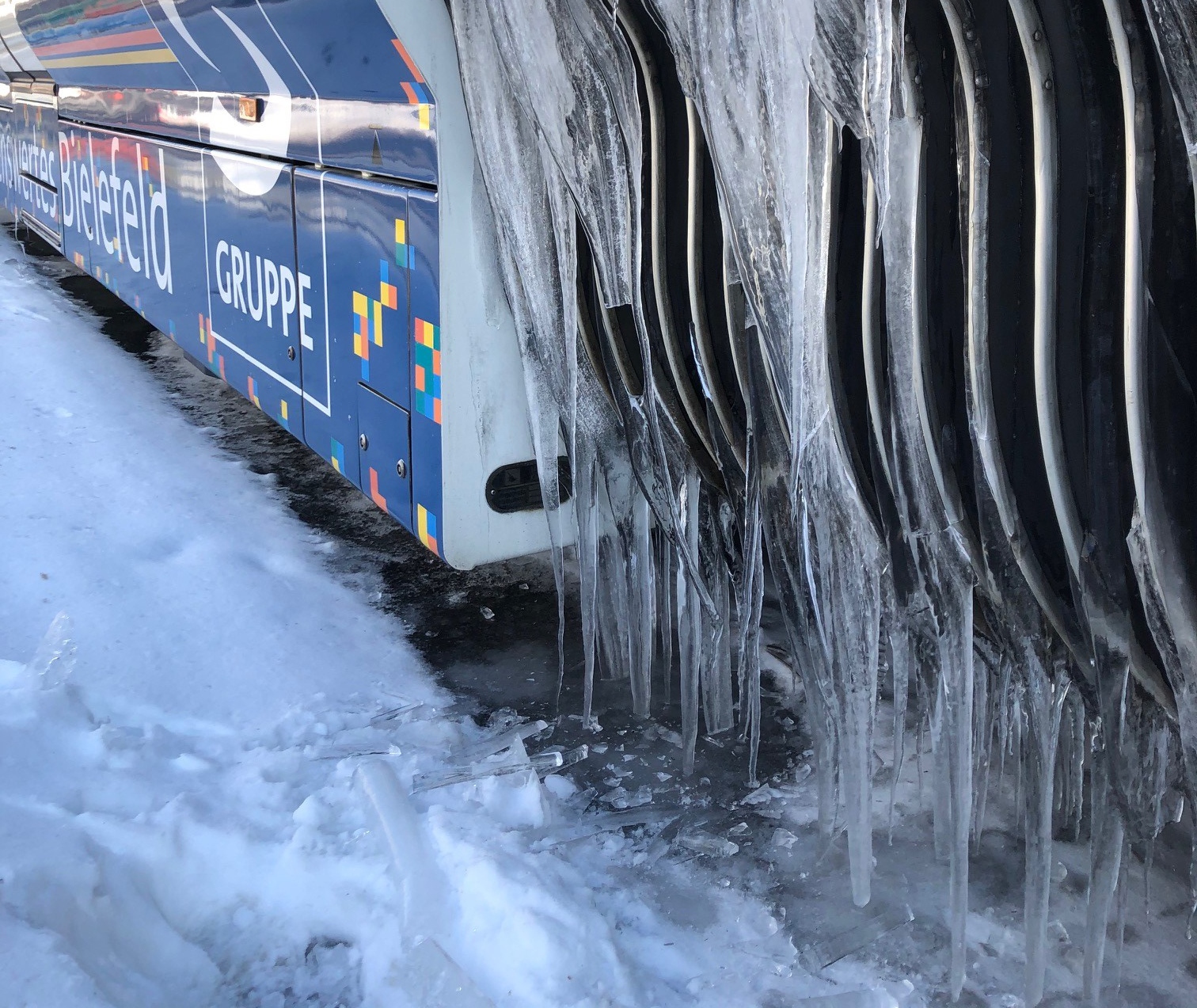
Most people from Bielefeld will get to work on Monday morning (15/02) by bus and tram. Only a few lines are not yet running again due to too much snow on the roadside or in the track bed. moBiel points out that passengers can use the mobility guarantee if journeys are cancelled. The trams of lines 1 and 4 are already running again on their complete route. Line 2 is running between Sieker and Schüco – there is a rail replacement service as far as Milse. Line 3 covers the area between the town hall and Babenhausen Süd. On the other branch in the direction of Stieghorst, the track bed will next be cleared of snow so that the Mitte hospital can be reached again as quickly as possible. Currently, passengers who want to go to Stieghorst should take line 2 to Sieker and from there bus line 138 to Stieghorst.
Bochum
BOGESTRA deployed various teams over the weekend to provide public transport services despite the adverse weather conditions. As a first step, on Sunday morning in Bochum and Herne, the the U35 line between Schloß Strünkede and Oskar-Hoffmann-Strasse in Bochum and Herne was operated again.
Braunschweig
Due to the weather conditions, bus and tram services were also suspended in Braunschweig on Sunday, 7/2 and Monday, 8/2 for the time being. After days of de-icing work, BSVG was able to resume some operations on Thursday afternoon, 11 February 2021. Service on tram line 4 between Helmstedter Straße and Helmstedter Straße and Inselwall was also resumed. Both were made possible because in the past few days additional drivers of the BSVG have been involved in clearing the blocked tracks of snow and ice.
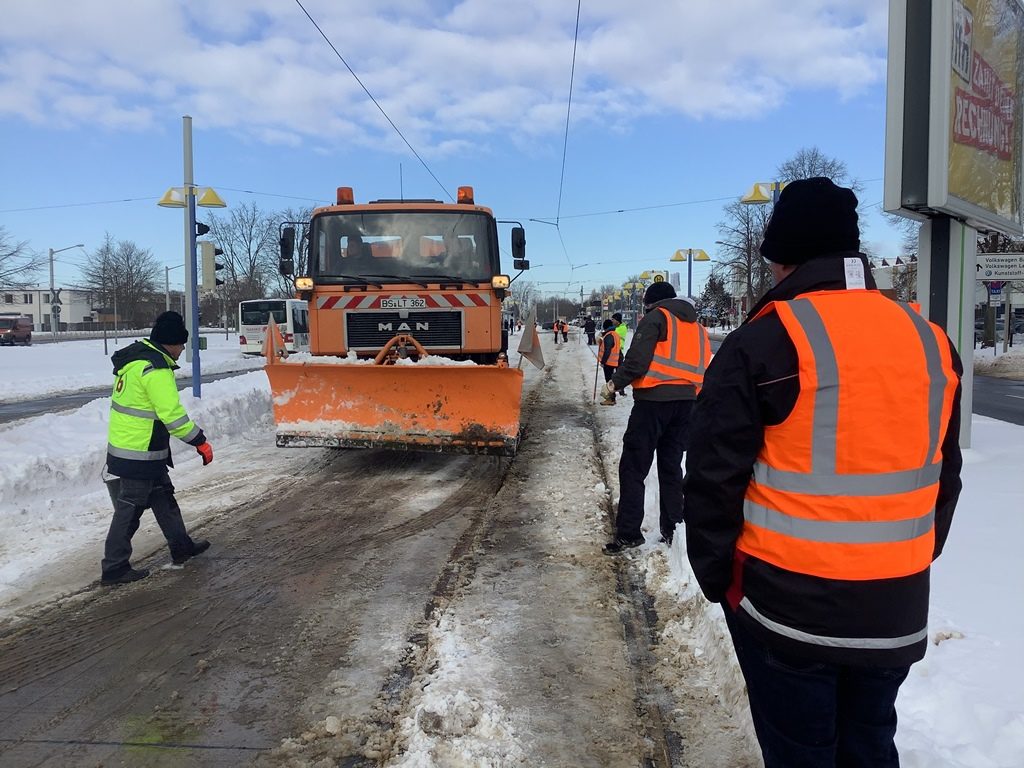
Dortmund
Public transport in Dortmund was also heavily affected by the snowfall. In the night of 6 to 7 February, the precipitation turned into freezing rain. which caused the roads to become slippery as glass. The buses were unable to operate their scheduled services. start scheduled services.
The DSW21 light rail network was “tracked” throughout the night: vehicles were deployed to prevent tracks and points from freezing or snowing over and overhead lines from icing up. Here, too, they were only partially successful. The U43 and U44 did not operate on Sunday. But in contrast to other cities, all light rail lines were able to gradually start operating in the course of the morning – albeit with considerable delays in some cases. Due to snow drifts, however, not all of Dortmund’s outer areas could be connected.
In Dortmund, even a tram got “stuck in the snow”. It was pushed by emergency services and passengers, as can be seen in the following tweet:
In the meantime, the situation in Dortmund has has returned to normal. This may be due to the fact that the tunnel location and the generously and its own generously dimensioned tracks, Dortmund’s light rail system is more “resilient” to the snow against the snow masses than systems running in the street frame.
Erfurt
In the Thuringian capital, too, tram and bus services were gradually suspended due to the snow. The first line to be affected was line 2 from Gothaer Platz to the main cemetery. At 10:30 a.m., information was received that services on the entire line had been suspended and a rail replacement service was was set up. Later in the day, the tram line 4 was also affected. Due to the snow, however, there were repeated major delays in service. EVAG kept its passengers informed via Twitter and Facebook. However, the service in Erfurt was not completely closed and and on 10 February, most of the light rail lines were back in service. With With work trucks and snow ploughs and many snow shovels, the public transport routes could be the public transport routes were “cleared” of snow.

Essen/ Mülheim (ruhrbahn)
The rails, switches and overhead lines in Essen and Mülheim were also frozen due to the freezing rain and low temperatures. A snow guard, a rail vehicle that keeps the rails and overhead lines during the night, was not possible, as the railways could derail and the power supply via the frozen overhead lines could not be is not guaranteed.
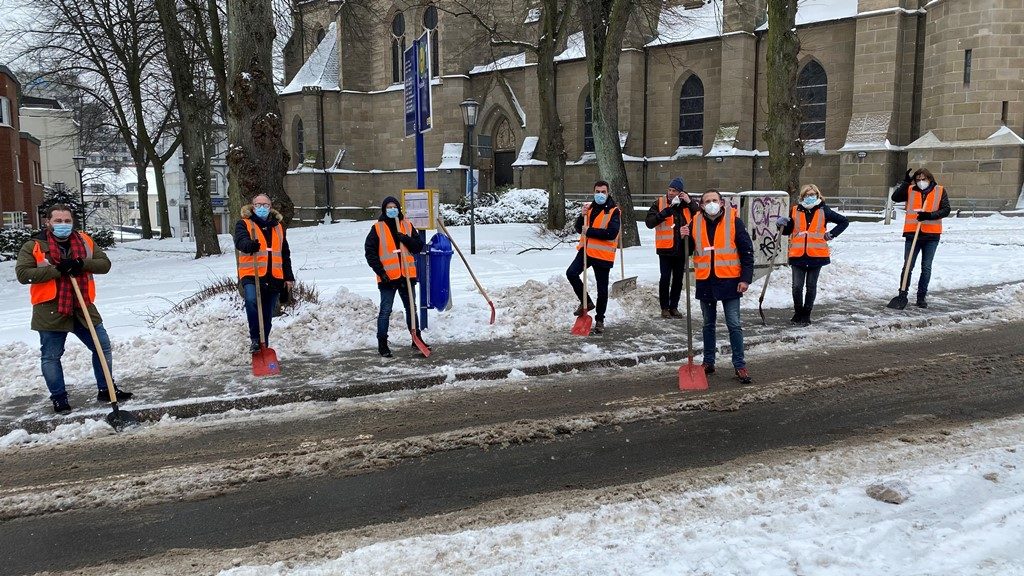
Uncovering the rails by hand with chisels and pickaxes was also tried. The problem was that the surrounding slush, which is pushed back into the rails by passing cars, immediately freezes again.
On the U18 line, a light rail line, the Ruhrbahn was able to clear the the overhead lines and points free of ice. This line can line can run because it runs on vignole rails, on a track that is independent from the independent of the rest of the road traffic. In the course of the week, all of the Ruhrbahn team has been working hard to reactivate the tram service as well. Equipped with shovels and snow pushers, the Ruhrbahn’s and snow shovels, Ruhrbahn managers cleared ice and snow from several stops in Essen and Mülheim an der Ruhr. Among them were the two managing directors Uwe Bonan and Michael Feller. Feller, who worked up a good sweat despite the cold.
For customers, the Ruhrbahn’s website explained in explained in detail why the traffic was brought to a standstill and why the snow clearance is such a difficult undertaking (in German):
https://www.ruhrbahn.de/essen/aktuelles/meldung/artikel/aktuelle-infos-zum-ruhrbahn-angebot-1.html
Hannover
Winter has Hannover’s public transport system firmly in its grip: While the buses of ÜSTRA and regiobus were running again on 11 February, light rail services in Hannover are still suspended. Numerous damages in the entire light rail network make a safe operation impossible. ÜSTRA is on the road with around 20 maintenance teams in the network to repair the damage.
The aim is to be able to put at least some sections of the line back into operation next Monday. Until then, the ÜSTRA asks its passengers to use suitable bus bus connections. These include in particular the SprintH lines of the regiobus.

The causes of the numerous damages are still being investigated. In particular, pavement slabs at crossings, but also bitumen and asphalt paving on tracks have been pushed upwards with the onset of the winter weather, so that they can no longer be driven over by the light rail vehicles. Initial assumptions assume that the heavy rainfall before the onset of the winter weather has saturated the subsoil with water. The frost caused by the drop in temperature then pushed the slabs upwards. It is also possible that the light rail vehicles pushed snow underneath the installations when they were moving, causing them to be lifted. A combination of both causes is also conceivable.
Leipzig
Also in Leipzig the transport companies and all those involved were in tireless action. On LVB’s website announced that they are working with great commitment to get out of the “flockdown”. All employees were working tirelessly, so that the tram traffic, which had come to a standstill, could be resumed in the second half of the week. On 11 February, 80% of the lines were back in service. Particularly the commitment of the public: a local resident provided a stranded tram driver with sandwiches. Another brought alcohol-free children’s punch to warm them up. On Saturday, 13 February, a good 40 junior handball players helped to clear the track from Wahren to Schkeuditz. This made one of the last missing stretches of track passable.
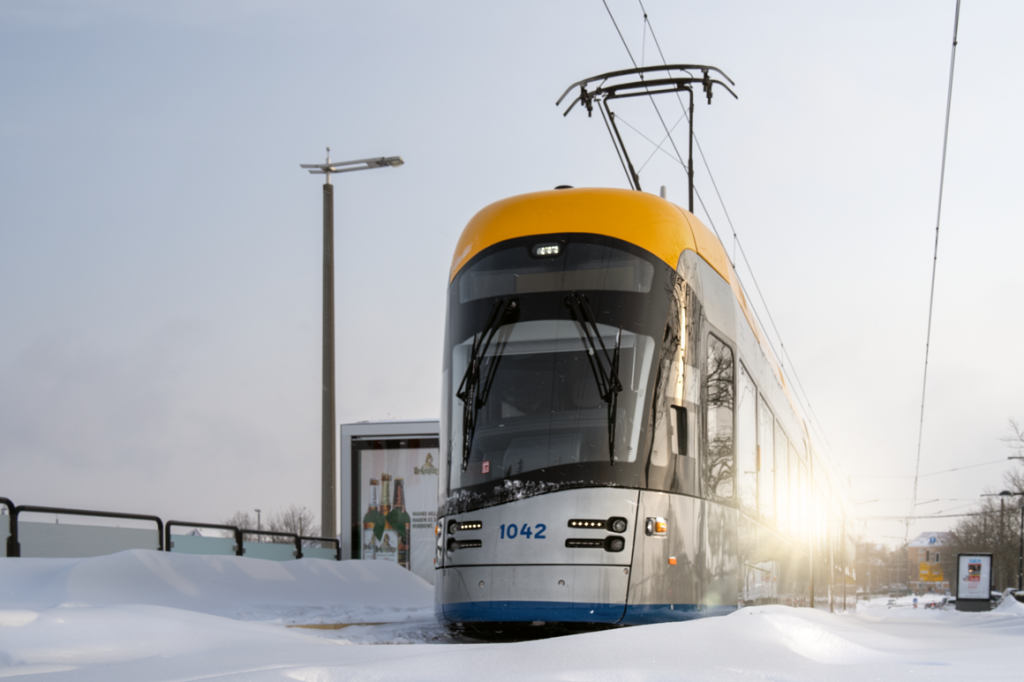
Leipzig Solaris Tramino tram in the snow I © Jan Rennert 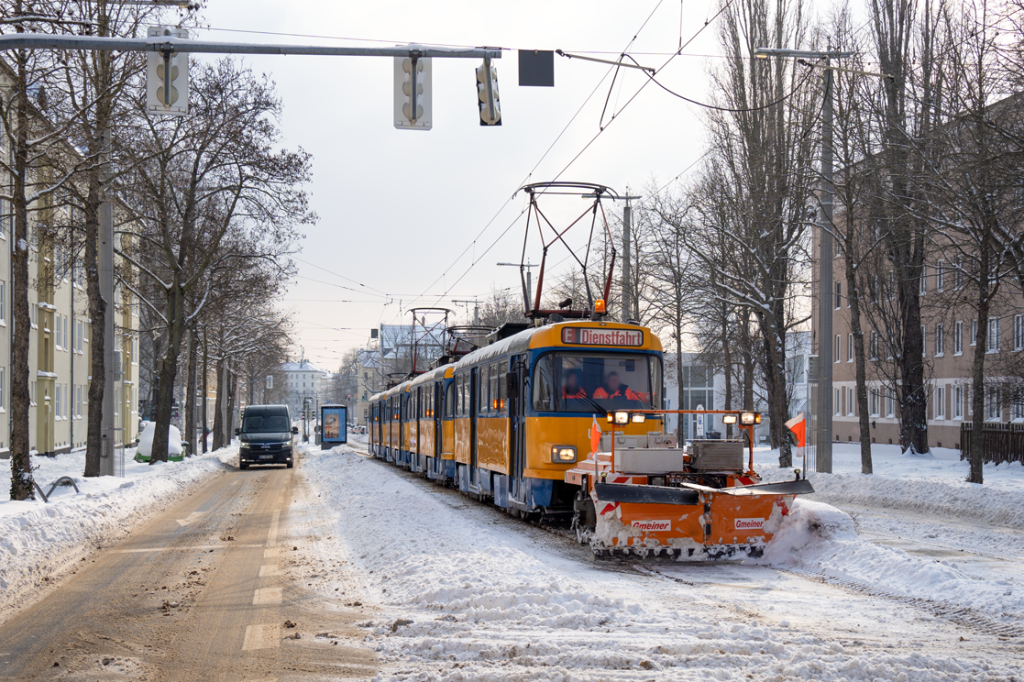
Snow plough with quadruple Tatra power in Leipzig I © Jan Rennert
Magdeburg
Tram and bus services operated by Magdeburger Verkehrsbetriebe GmbH & Co. KG (MVB) was temporarily suspended on Monday, 8 February. The emergency service set up by MVB on the night line network during the night from Sunday to Monday had to be discontinued again after numerous buses got stuck on the roads and could no longer continue.
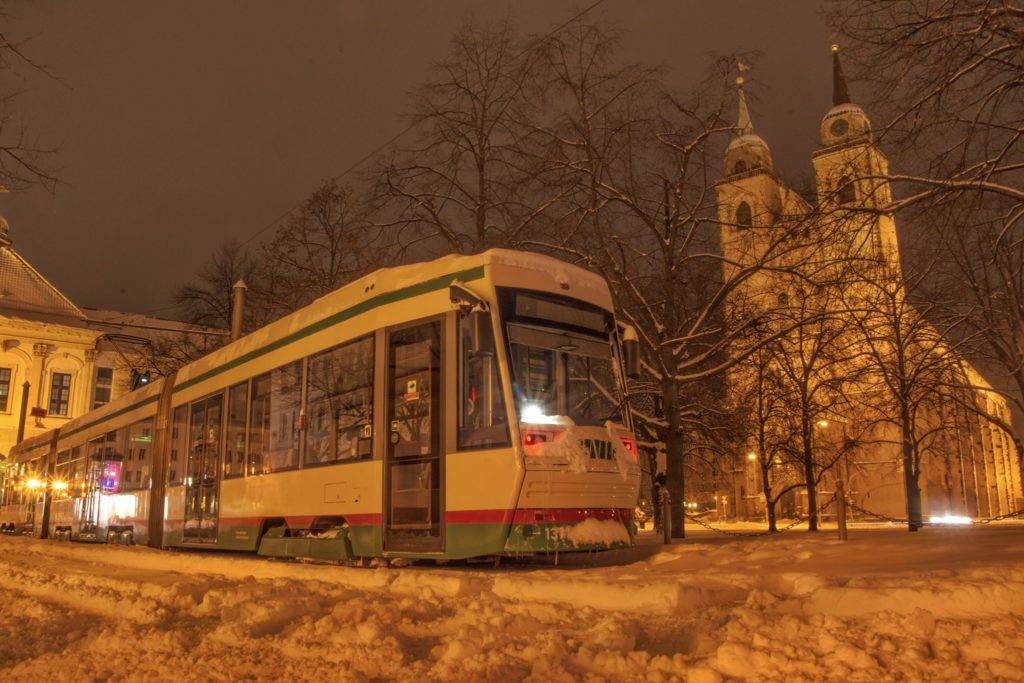
Parked NGT8D low-floor tram of MVB Magdeburg I © MVB 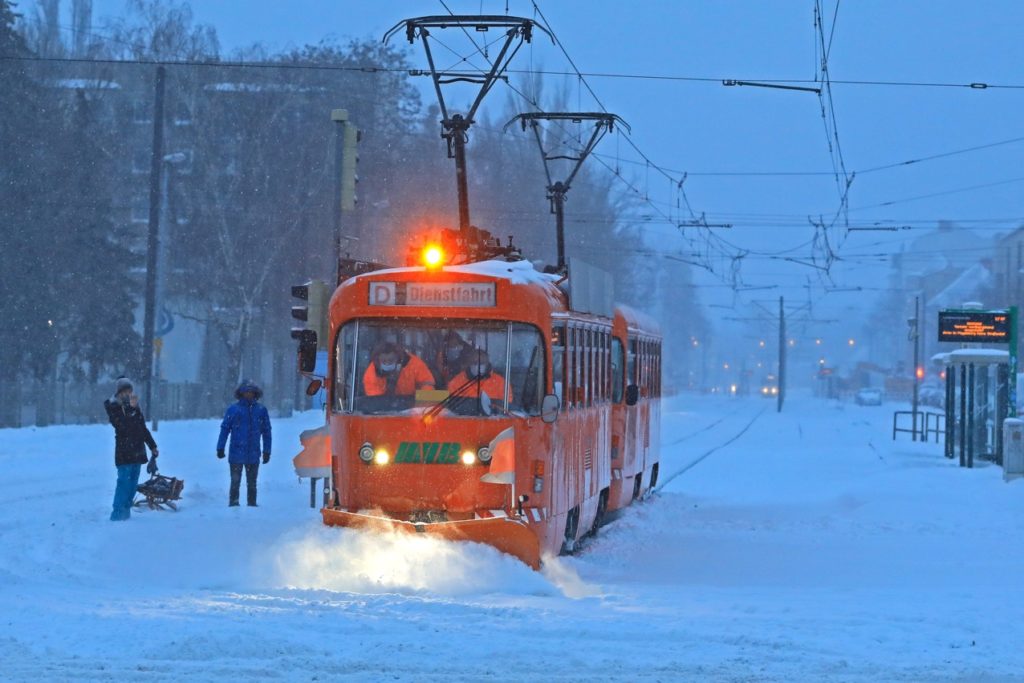
Two Tatra work cars fight their way through the snow with a snow plough I © Peter Gercke/ MVB 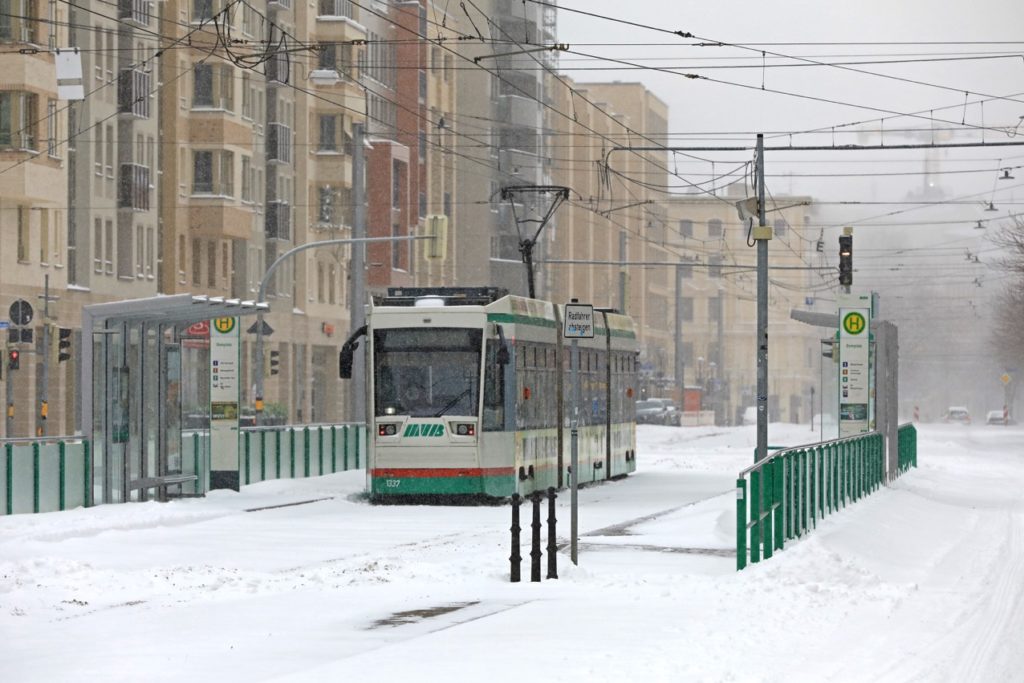
Due to the blocked tracks, not all vehicles could be brought to the depot I © Peter Gercke/ MVB 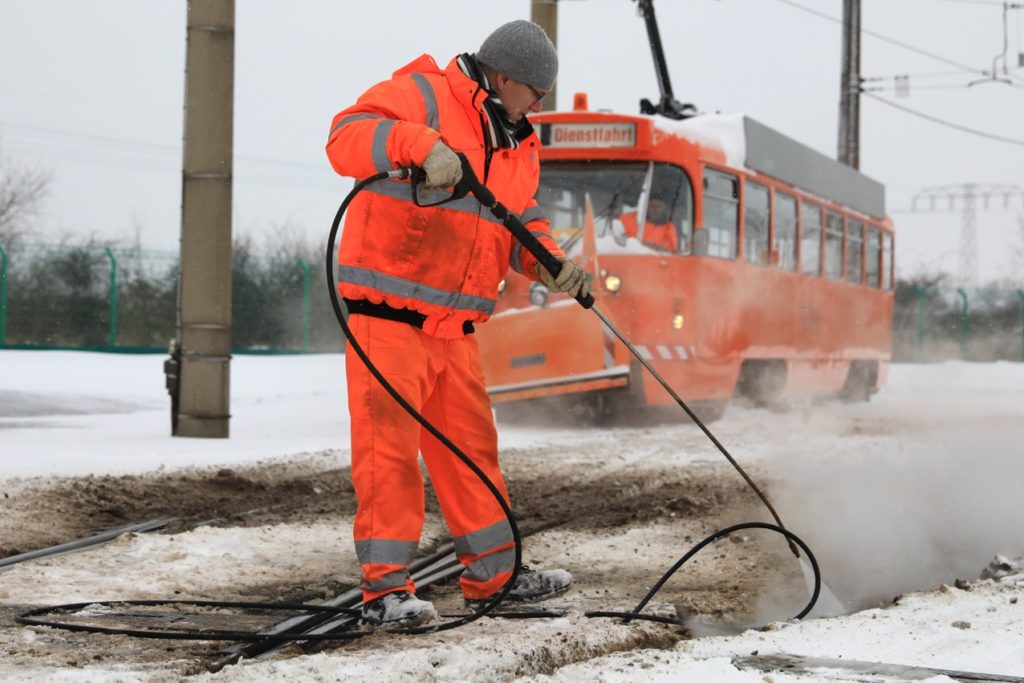
Removing snow and ice from the grooved rails is particularly time-consuming I © Peter Gercke/ MVB
After two and a half days MVB put the first tram line back into operation on Tuesday, 9 February. From around 4 p.m., line 8 was in operation between Neustädter See and Westerhüsen. Gradually, the remaining tram lines were also put back tram lines were put back into operation. Thanks to the tireless efforts of innumerable employees many sections of track were cleared of snow and ice, so that nearly almost all connections are possible again. As things stand at the moment (13.02.), the lines the routes Breiter Weg Südabschnitt and Messegelände Herrenkrug remain closed. The section Hauptbahnhof Olvenstedter Platz Olvenstedter Platz could be put into operation. The officers helped to remove vehicles that were parked incorrectly.
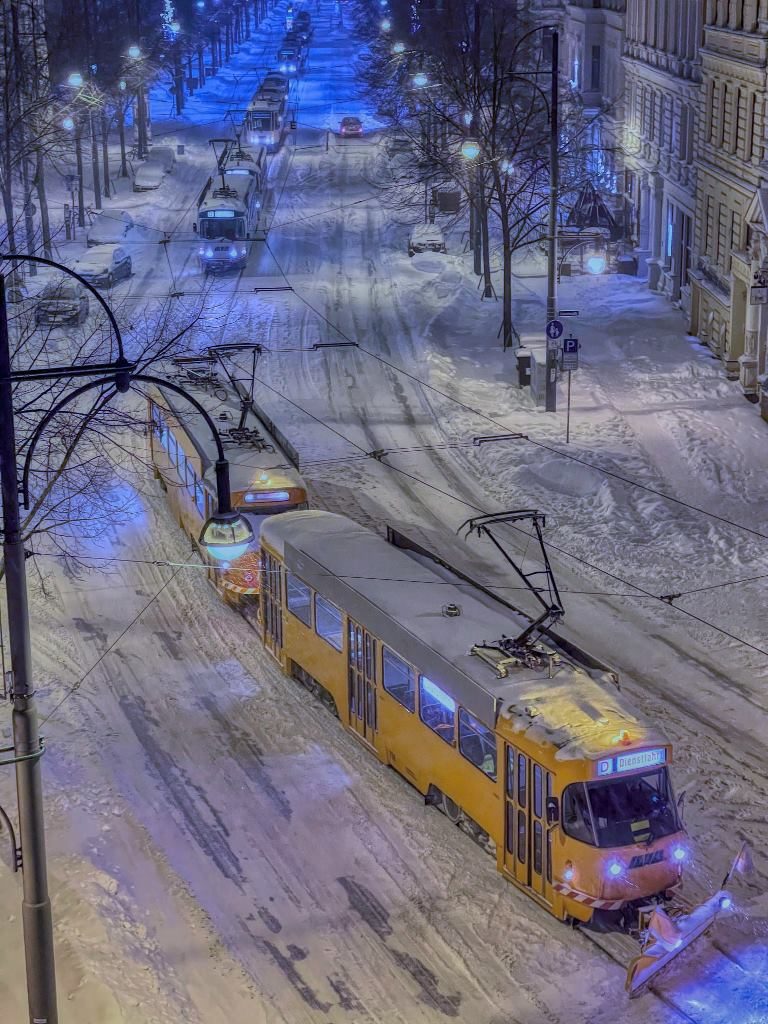
The section of the Westring Diesdorf is expected to be cleared on Friday night, so that, according to the current forecast, it can be served by line it can be served by line 6 again.
Status Monday, 15/02, all tram lines are back in service.
Naumburg
The 2.8 km long Naumburg tramway also had to stop operating due to the snow, but was able to resume operations relatively quickly.
Since Tuesday, 9.2. from it has been operating the section between the Salztor terminus and the Jägerplatz stop according to the timetable.
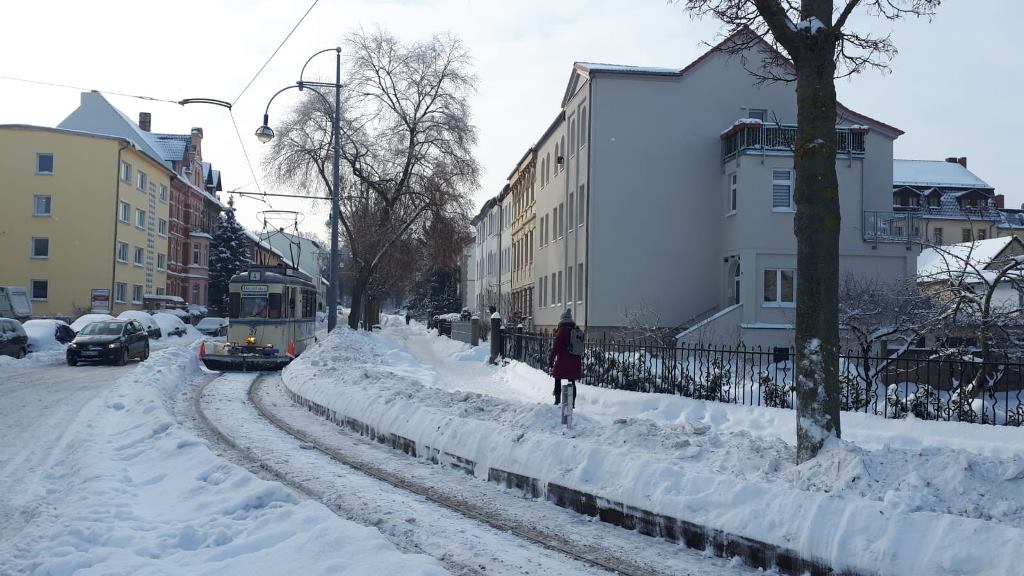
The Naumburg tramway gradually reopened I © Naumburger Straßenbahn GmbH 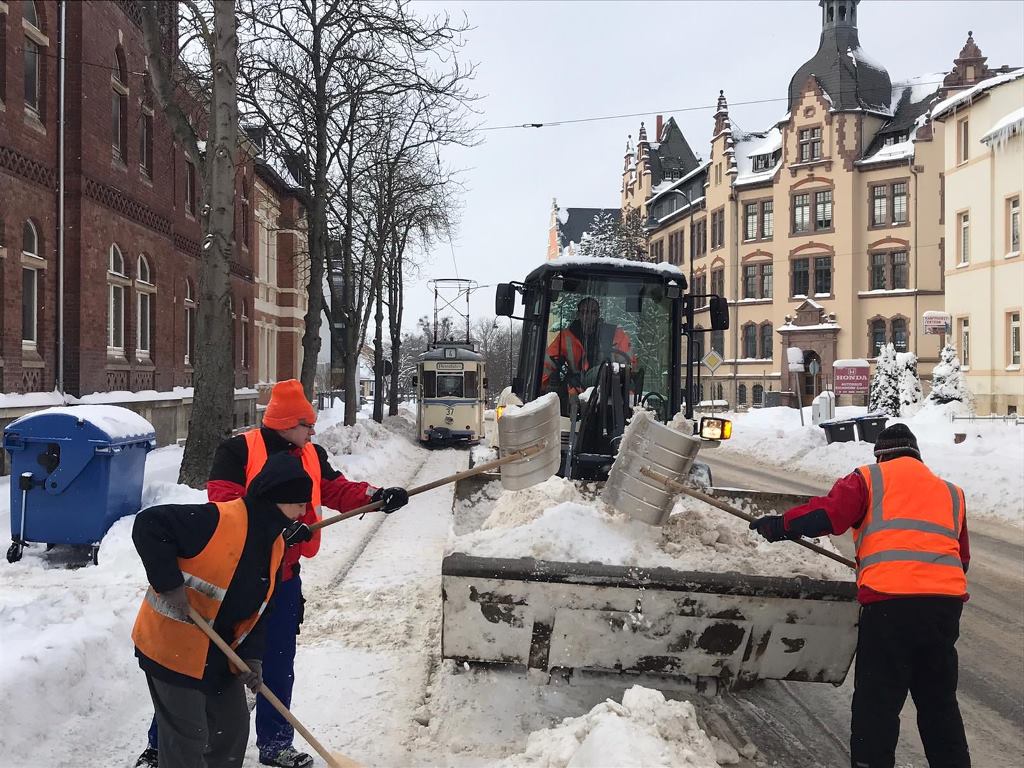
Joining forces: shovelling snow on the Naumburg tramway I © Naumburger Straßenbahn GmbH
For the permanent track and and points, as well as for clearing purposes, regular trips with the tram snowplough have been taking place regular trips with the tram snow plough have been taking place on the entire line since the weekend. Nevertheless repeatedly happened that even this snow plough got stuck in the masses of snow. On Monday evening, the service railcar with the snow plough was only able to find its way to the only thanks to the construction company EGW Müller GmbH. Without heir spontaneous snow-clearing support with an excavator on Bergstraße, the vehicles would have would have been permanently stuck.
The building yard of the city of Naumburg, supported by members of the association Nahverkehrsfreunde Naumburg – Jena e.V., are working on the section between Jägerplatz and the main station can be used again. can be used again.
Nordhausen
The small 6.2 km long tram network in Nordhausen also had to temporarily stop operation. The track network was cleared of snow with numerous snow ploughs and the historic Gotha railcar 40, which pushed a snow plough. Where possible, substitute bus services were arranged. Service on tram lines 1 and 10 (dual-system tram on the tracks of the Harzer Schmalspurbahn to Ilfeld) resumed in the afternoon of 10 February. Line 2 resumed regular service on 12.02. A video of the snow ploughing operation in Nordhausen is available here:
Deutsche Bahn
After the extreme storms over large parts of Germany, rail traffic continues to return to normal. Since last weekend, thousands of DB employees have been working around the clock to offer passengers reliable and stable rail services again. Over the last few days, it has been possible to gradually return to the metropolises and to slowly start regional services in many places. More than 22,000 snow-clearing teams were deployed to clear stations of snow and ice. Around 95 per cent of the railway network can be used again – but often with restrictions and sometimes long delays. Where things are not yet running smoothly, snow, icy overhead lines and temperatures as low as minus 26 degrees Celsius will continue to make the work of the clearing and repair teams difficult over the next few days. Currently, there are still major regional restrictions in the Harz-Weser network and in Thuringia.
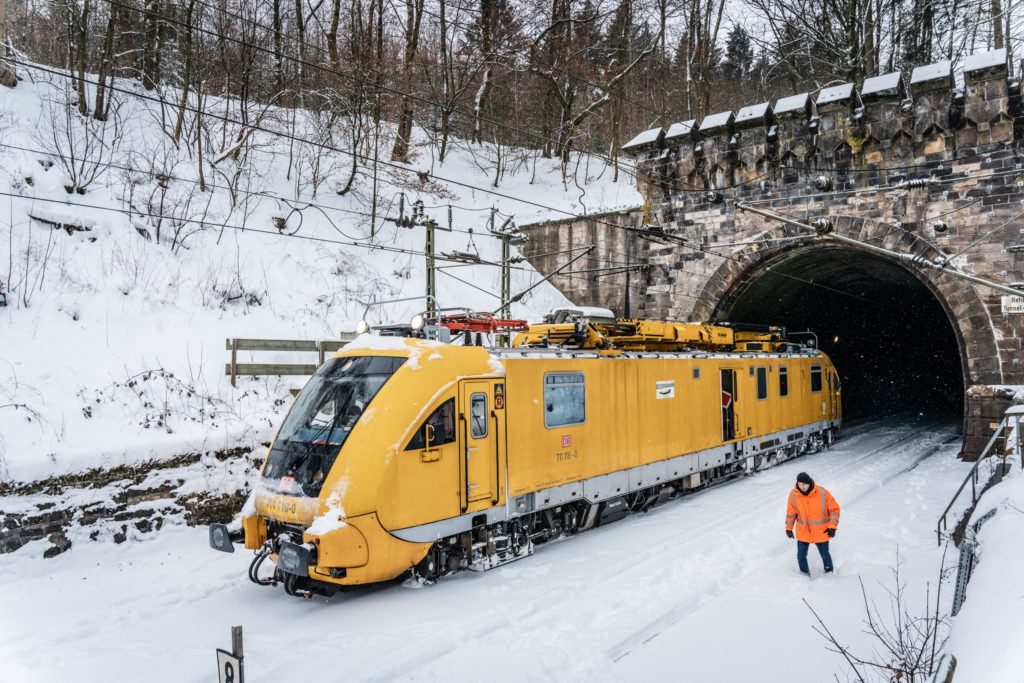
Where Deutsche Bahn emergency services can no longer make headway with manual labour and heavy clearing equipment, the experts inspect the situation from the air. Experts are on the move by helicopter along the railway line between Halle and Erfurt.
The weather did not catch DB unprepared last weekend. Work teams met, snow clearing crews were on standby and clearing vehicles were withdrawn to the affected areas. The forecasts and warnings of the German Weather Service (DWD) were constantly incorporated into the situation assessments. The force of the snow, wind and ice then caused severe restrictions in the affected areas, as it did in many places. The top priority during the storm was the safety of passengers and employees. To this end, DB adjusted its transport services at an early stage and on the basis of the weather forecasts of the DWD. Train traffic was reduced in a targeted manner, especially where the highest warning levels were in effect, in order to avoid congestion situations in rail traffic as well. The DB crisis managers’ concept worked: At no time did passengers have to be evacuated from long-distance or regional trains on open tracks.
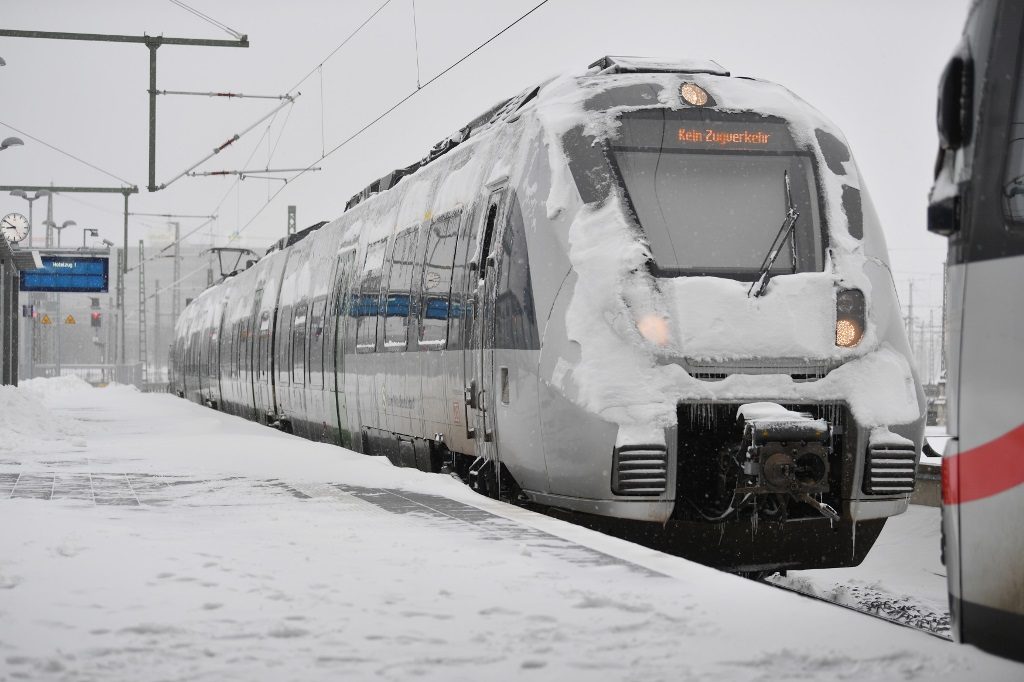
There was also a quick response in the stations, with a peak of 14 lounge trains providing warm-up facilities for travellers. Hotel capacities were also available for passengers. Around 2,000 taxi and hotel vouchers have been issued to date. Those who could were asked not to start their journey or to do so at a later time. The rail customers showed great understanding in this doubly difficult stressful situation, also for DB staff, resulting from the Corona lockdown and extreme winter, and postponed their train journey. Anyone who had questions about the current situation or needed help with rebooking and cancellations called the DB special hotline. The staff there have made over 90,000 calls around the clock since Saturday.
